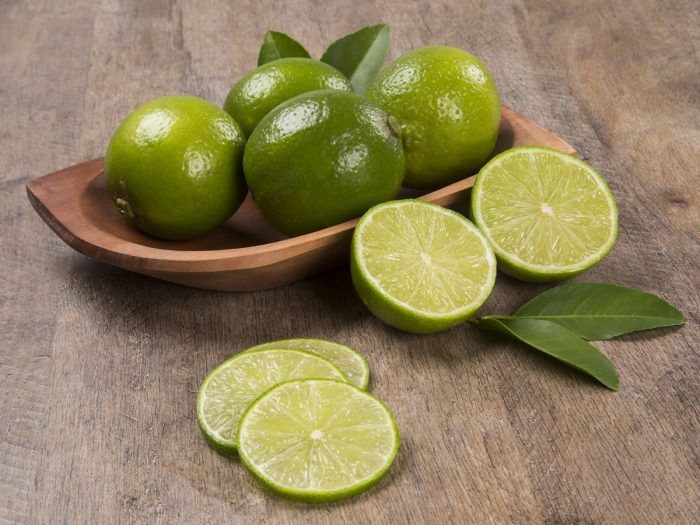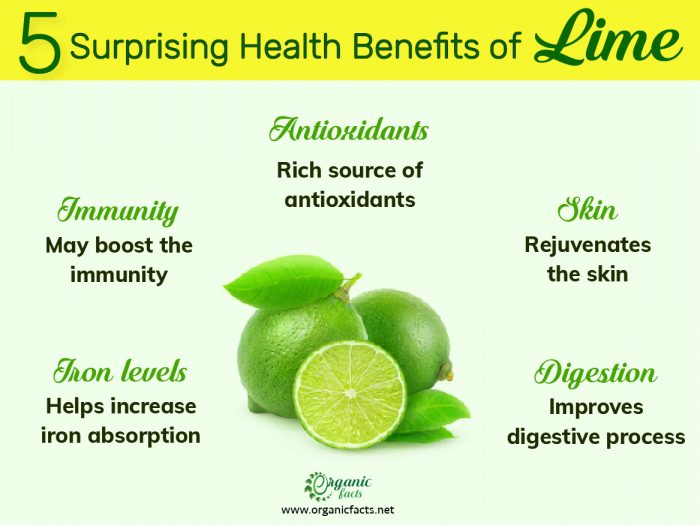Lime is a citrus fruit packed with vitamin C and antioxidants, supporting immune function, improving digestion, and promoting skin health. It helps with weight management, reduces respiratory disorders, and enhances overall wellness. Lime can also be used to treat conditions such as scurvy, peptic ulcers, and skin issues.
What is Lime?
Lime (Citrus aurantifolia) is a small, round, green-color hybrid citrus fruit. Due to its acidic sour juice and unique aroma, the lime fruit is widely used in various cuisines to accent flavor. It is a common ingredient in Mexican, Vietnamese, and Thai cuisine. There are several species of citrus fruits referred to as limes that include key lime, kaffir lime, wild lime, desert lime, and Persian lime. [1]
This zesty, tropical fruit is well-known for its medicinal properties for ages. Lime finds its application in cosmetic and health products, too. Extracted from the lime’s peel or skin, the lime essential oil is extensively used in aromatherapy and perfumes. [2]
| Serving Size : | |
|---|---|
| Nutrient | Value |
| Water [g] | 88.26 |
| Energy | 30 |
| Energy [kJ] | 126 |
| Protein [g] | 0.7 |
| Total lipid (fat) [g] | 0.2 |
| Ash [g] | 0.3 |
| Carbohydrate, by difference [g] | 10.54 |
| Fiber, total dietary [g] | 2.8 |
| Sugars, total including NLEA [g] | 1.69 |
| Calcium, Ca [mg] | 33 |
| Iron, Fe [mg] | 0.6 |
| Magnesium, Mg [mg] | 6 |
| Phosphorus, P [mg] | 18 |
| Potassium, K [mg] | 102 |
| Sodium, Na [mg] | 2 |
| Zinc, Zn [mg] | 0.11 |
| Copper, Cu [mg] | 0.07 |
| Manganese, Mn [mg] | 0.01 |
| Selenium, Se [µg] | 0.4 |
| Vitamin C, total ascorbic acid [mg] | 29.1 |
| Thiamin [mg] | 0.03 |
| Riboflavin [mg] | 0.02 |
| Niacin [mg] | 0.2 |
| Pantothenic acid [mg] | 0.22 |
| Vitamin B-6 [mg] | 0.04 |
| Folate, total [µg] | 8 |
| Folate, food [µg] | 8 |
| Folate, DFE [µg] | 8 |
| Choline, total [mg] | 5.1 |
| Vitamin A, RAE [µg] | 2 |
| Carotene, beta [µg] | 30 |
| Vitamin A, IU [IU] | 50 |
| Vitamin E (alpha-tocopherol) [mg] | 0.22 |
| Vitamin K (phylloquinone) [µg] | 0.6 |
| Fatty acids, total saturated [g] | 0.02 |
| 14:0 [g] | 0 |
| 16:0 [g] | 0.02 |
| 18:0 [g] | 0 |
| Fatty acids, total monounsaturated [g] | 0.02 |
| 16:1 [g] | 0 |
| 18:1 [g] | 0.02 |
| Fatty acids, total polyunsaturated [g] | 0.06 |
| 18:2 [g] | 0.04 |
| 18:3 [g] | 0.02 |
| Tryptophan [g] | 0 |
| Lysine [g] | 0.01 |
| Methionine [g] | 0 |
| Sources include : USDA [3] | |
Lime Nutrition
Predominantly known for its ascorbic acid reserves, lime may provide 32 percent of the daily recommended intake of vitamin C. It has high water content and important vitamins and minerals like magnesium and potassium, as well as vitamins like folate, vitamin A, vitamin E, and vitamin K.
The best thing about limes is that they are low in calories, carbohydrates, and fats. According to the USDA National Nutrient Database [4], a single serving (67 g) of lime may provide 20 kcal of energy. Moreover, lime peel and pulp may be rich in dietary fiber, antioxidants, flavonol glycosides like kaempferol, as well as diverse phytochemicals like polyphenols, limonene, and terpenes.
Health Benefits of Lime
Let’s take a look at some of the health benefits in detail:
May Help In Skin Care
Lime juice may contain healthy acids and help remove dead cells when applied to the skin. It might help build collagen, rejuvenate the skin, and improve overall texture. [5]
Vitamin C protects the skin from infections as well as cures rashes, acne, pimples, bruises, and blemishes. As per a study in the journal Nutrition, flavonoids contained in limes may also inhibit microbial growth, which might help prevent gum bleeding. [6]
It may also help fight skin damage caused due to sun, dust, and pollution. Its antioxidant and astringent properties can be helpful in reducing wrinkles, diminish dark spots, skin tan, and open pores. You can create a refreshing bathing experience by just adding this juice to your bath. Moreover, it may also help reduce body odor. [7] [8] [9]
For ages, the use of lime has been a well-known cure for scurvy, a disease caused by vitamin C deficiency. It is characterized by frequent infections that show normal cold symptoms, cracked lips, and lip corners. [10]
May Aid in Digestion
Limes have an irresistible aroma that may aid primary digestion (the digestive saliva floods your mouth even before you taste it). While they break down the macromolecules of the food, the flavonoids stimulate the digestive system and increase the secretion of digestive juices, bile, and acids. This might also stimulate peristaltic motion which moves the food throughout the intestine.
The amount of acid present in lime may help clear the excretory system. The roughage in lime may aid in providing relief from constipation. An overdose of its juice with salt may also act as an excellent purgative without any side effects, thereby relieving constipation.
Note: This is the reason behind lemon pickle being consumed along with lunch and dinner in India, and various neighboring countries. Also, drinking a glass of warm lime water about 30 minutes before meals can help prevent heartburn or acid reflux symptoms.
May Fight Infections
Consuming lime may protect the body against various microbes, viruses, and bacteria including Helicobacter pylori (H. pylori) and Salmonella bacteria infections. [11]
May Aid In Weight Loss
A 2010 animal study showed that lime essential oils may help prevent weight gain and excess food consumption. Moreover, the citric acid present in lime might also be an excellent fat burner. A glass of lukewarm water with lime can be effective as an excellent weight reducer. [12]
How to use: Consume two glasses of warm water with lime juice a day to reap benefits in a few days.
May Manage Blood Sugar
The high levels of soluble fiber found in lime may make it effective and regulate the body’s absorption of sugar into the bloodstream. This may help reduce the risk of blood sugar spikes that are a serious risk to people with diabetes. [13]
Also, limes and other citrus fruits have a low glycemic index, which may imply zero significant or unexpected spikes in glucose levels. This is why the American Diabetes Association considers citrus fruits such as limes a superfood for diabetes. [14]

When life gives you limes and lemons, use them to make your cocktails tangy! Photo Credit: Shutterstock
May Relieve Inflammation
Citrus fruits may have anti-inflammatory properties and can be used for several inflammatory issues.
One of the many causes of arthritis is an excess build-up of uric acid in the body. The citric acid found in limes is a solvent in which uric acid can dissolve. Increasing citric acid in the body may help eliminate excess uric acid from the urine. [15] [16]
May Prevent Kidney Stone
According to a 2014 study in the Korean Journal of Urology, the citric acid in fresh or concentrated lime juice may help remove and prevent kidney stones by increasing urinary citrate and urine volume. [17]
Another study showed that consuming lemonade for nearly four years may have helped decrease kidney stone formation from an average of one stone per year down to just 0.13 per year. [18]

Lime is a small, round, green-color hybrid citrus fruit. Due to its acidic sour juice and unique aroma, it is widely used in various cuisines to accent flavor.
May Boost Immunity
Lime may strengthen the body’s line of defense and help ward off infections and diseases like malaria, and diarrhea. Also, vitamin C in the citrus fruit might help battle coughs and colds and boost the body’s overall immunity. This is confirmed by a series of studies including a 2017 research in the journal Nutrients. [19] [20]
May Increase Iron Absorption
Vitamin C in lime when paired with foods rich in iron, may help maximize the body’s ability to absorb iron. Additionally, those suffering from iron-deficiency anemia symptoms like – dizziness, brittle nails, hair loss, and fatigue may consider adding lime to their diet. [21] [22]
May Heal Peptic Ulcer
In addition to vitamin C, lime may contain special compounds called flavonoids (limonoids such as limonin glucoside), which have antioxidant, anti-carcinogenic, antibiotic, and detoxifying properties. The acids in lime react with the gastric juices of the stomach resulting in alkaline reactions. The flavonoids and the alkaline reaction collectively may stimulate the healing process of peptic and oral ulcers. [23]
May Provide Relief from Respiratory Disorders
The flavonoid-rich oil that is extracted from limes may be extensively used in anti-congestive medicines such as balms, vaporizers, and inhalers due to the presence of kaempferol. Just scratching the peel of a lime and inhaling it might give immediate relief from nasal congestion and nausea.
Other benefits
Other benefits include:
- May Alleviate Fever: Citrus fruits, in general, have fever-reducing qualities because of vitamin C found in high concentrations, which may naturally lower the temperature of the body. [24]
- May Provide relief from Gout: There are two main causes of gout. The first source is the accumulation of free radicals and the second is the accumulation of toxins in the body, primarily uric acid. Limes may help prevent both of the causes, due to the presence of abundant antioxidants, vitamin C, and flavonoids. [25]
- May Help Relieve Piles: Since lime may help heal ulcers and wounds in the digestive and excretory system (while providing relief from constipation) it might also remove some of the root causes of piles. Piles are a different term for hemorrhoids, an uncomfortable condition that occurs in the anal region, and can result in bleeding and discomfort during excretion. It may help prevent their formation or recurrence. [26]
- May Help with Urinary Disorders: The high potassium content in limes is may be very effective in the removal of toxic substances and the precipitates deposited in the kidneys and the urinary bladder. The disinfectant properties of lime might also help cure infections in the urinary system. Furthermore, it may stop prostrate growth (very common in males above 40) and clear blockage of urine caused due to the buildup of calcium in the urinary tract.
- May Help In Hair Care: Applying lime juice to the scalp may have tremendous benefits like shiny, healthy, and dandruff-free hair and scalp. Apply lime juice to your hair and expose it to sunlight for an hour. Then, rinse it. This will make your hair 2-3 shades lighter in color. [27]
- May Boost Women’s Health: Calcium and folate present in it are two important nutrients for women in menopausal and child-bearing age.
What is Lime Used For?
Limes may have many surprising medicinal, culinary, and cosmetic uses. Some are as follows: [28]
- Culinary Uses: Lime juice adds a tart flavor to soups, salads, vegetables, and baked foods. Squeezing some lime juice onto roasted chicken or pan-fried white fish can add a tangy taste to it. It is also widely used in the preparation of desserts, pickles, jams, jellies, snacks, and candies.
- Cleansing Agent: It can easily increase the cleansing properties of any facial cleanser or shampoo by merely adding 2-3 drops.
- Aromatherapy & Perfumes: Lime essential oil is used in aromatherapy and perfumes for its fragrance and its stimulating effect on the body and mind.
- Beverages: It is a favorite ingredient when it comes to cocktails, sorbets, and fresh beverages.
- Cosmetic Products: It is used in cosmetic products like body oil, hair oil, toothpaste, beauty soap, disinfectant, mouthwash, and deodorant.
- Medicinal Uses: Because of their antibacterial, antiseptic, and disinfectant properties, the peel, oil, and juice of the fruit may have medicinal uses. It may also be used in making anti-congestion medicines and to treat severe diarrhea.
How Much Juice is in a Lime?
One pound consists of 5 limes. On average, one lime contains 2 tablespoons of lime juice present in it. One whole lime also has 2 teaspoons of lime zest in it. So, if a recipe asks for the juice of 1 lime, you can substitute it with 2 tablespoons of bottled lime juice.
Side Effects
Although limes do not have major side effects, excessive intake may cause some issues like:
- Skin allergy: Itchiness, redness, and swelling. [29]
- Citrus fruit allergy: Nausea, abdominal pain, wheezing, repeated vomiting. [30]
- Eroded enamel: Over-consumption may erode the tooth enamel and increase its sensitivity due to the high amount of citric acid.
- Phytophotodermatitis: In some cases, applying the lime juice to the skin directly may increase skin sensitivity to UV rays, resulting in phytophotodermatitis. [31]
Note: It is important to wash the outer peel of limes even if you do not plan to use it as the peel usually has bacterial deposits. These may get transferred inside the fruit if kept unwashed.
Other than that add this zesty fruit to your diet and enjoy all its nutrition!
